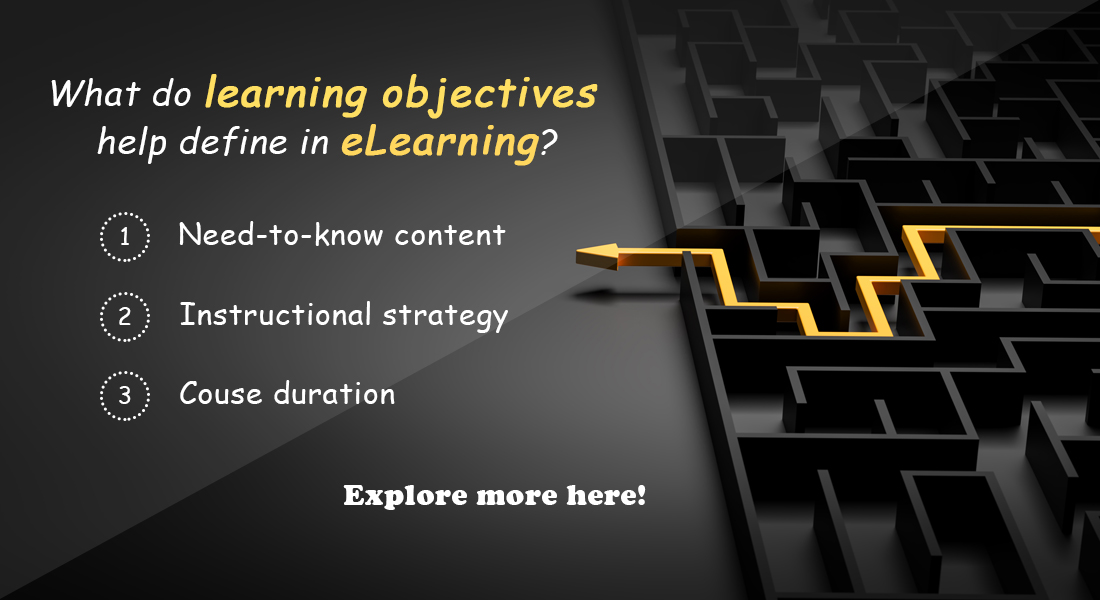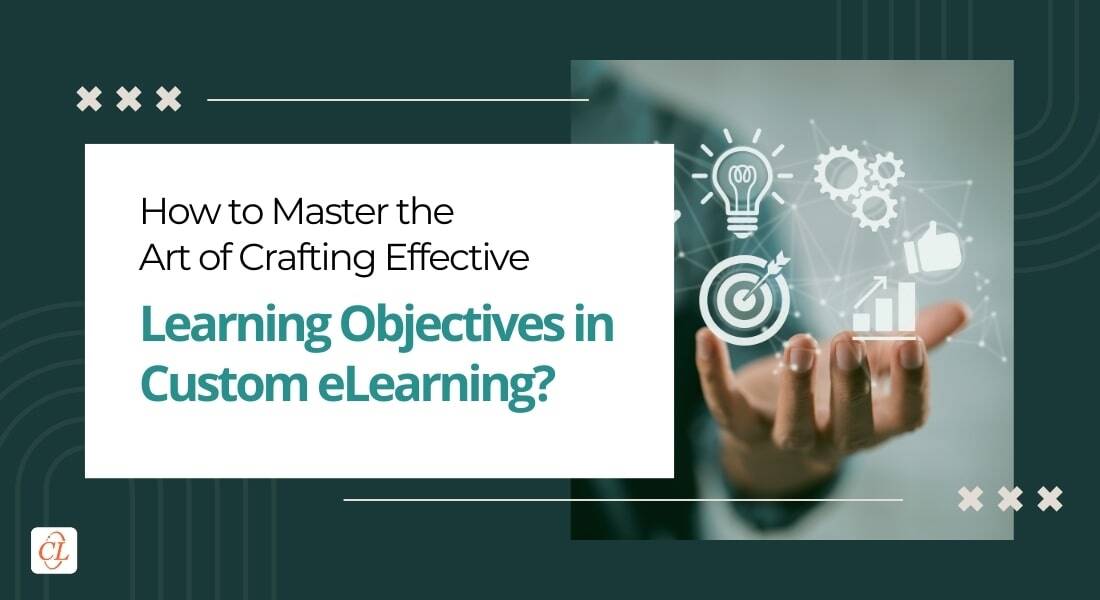Why You Shouldn’t Skip Setting Learning Objectives for eLearning

Without clearly defined goals, don’t many of us find ourselves losing track while finishing our tasks at hand? So could be the case with learners taking eLearning courses that cover multiple topics and have a lot of content, if they don’t know what to expect from it. An eLearning course is meant to bridge the gap between a learner’s current and expected performance by equipping them with the required knowledge, skills, and attitude, and helping them apply and practice what is learned. But how do we know if the training has benefited learners as expected? Learning objectives can help!
Explore the different areas training can help in achieving business goals.
What are Learning Objectives?
Having a specific and measurable description of what a learner will be able to do on completion of the eLearning course can help assess learners and the effectiveness of the course itself – this description is known as a learning objective.
| A learning objective is a statement, in specific and measurable terms, that describes what learners will be able to do on completion of an eLearning course. |
Why Set Learning Objectives for eLearning?
Learning objectives set the stage for eLearning course development. They define the goals to be achieved and help design eLearning courses in alignment with the end result. Defining learning objectives at the beginning of the course also fulfills the adult learning principles of letting adults know why they should learn something and what problems the eLearning will help them solve.
They also act as a good tool to evaluate whether the eLearning course has achieved its purpose.
What are Learning Objectives?
A learning objective is a statement, in specific and measurable terms, that describes what learners will be able to do on completion of an eLearning course.
By the end of this blog, you will be able to:
- Define learning objectives
- List the components and characteristics of good learning objectives
- Identify the components of eLearning that learning objectives help define
Components of Learning Objectives
Ideally, learning objectives should have three components:
1. Performance
It is a description of what the learner is expected to DO, after the eLearning.
2. Condition
It describes the environment under which learners are expected to perform.
3. Criteria
It describes the level of performance to be achieved for the learner to be considered competent.
| Example
By the end of the course, the learner should be able to write a program in C language, to add ten numbers, within the given time. Here: “Performance” is the learner being able to write a program to add ten numbers “Condition” is doing it using C programming language “Criteria” is do so before the time runs out |
Characteristics of Learning Objectives
Learning objectives in eLearning should be SMART, that is:
Specific – They should say exactly what learners should be able to do after the training
Measurable – They should be observable and quantifiable
Attainable – Learners should be able to accomplish them without external help and within the specified conditions
Relevant – They should apply to learners’ job roles and tasks
Targeted – They should be aligned to learners’ expected performance level
The Role of Bloom’s Taxonomy in Setting Learning Objectives
The popular Bloom’s Taxonomy plays an important role in setting performance-based learning objectives for eLearning. Dr. Benjamin Bloom, an Educational Psychologist, identified 3 domains of learning: Cognitive (knowledge-based), Affective (attitude-based), and Psychomotor (skill-based).
The Cognitive domain has 6 levels and Bloom’s Taxonomy provides a list of action verbs to describe what the learner will be able to do. A verb should be selected based on what learners are supposed to achieve and the verb selected will drive the content to be included in the course and the appropriate assessment strategy.
The following is a list of action verbs for the six levels, with Remembering being the lowest level and Creating the highest.
|
Level |
Action Verbs |
| Remembering | Define, List, Recall, Recognize, Identify, Name |
| Understanding | Explain, Infer, Match, Compare, Distinguish, Summarize, Expand, Classify, Calculate, Describe, Interpret, Outline |
| Applying | Classify, Demonstrate, Execute, Solve, Use, Implement |
| Analyzing | Appraise, Compare, Contrast, Formulate, Examine, Test, Sequence, Structure |
| Evaluating | Appraise, Check, Critique, Judge, Monitor, Rate, Prioritize, Verify |
| Creating | Change, Combine, Design, Formulate, Invent, Improve, Generate, Plan, Predict, Produce, Compile |
What Do Learning Objectives Define in eLearning?
Scope of the Content
Content is an extremely important pillar of an eLearning course. Having a clear scope helps identify which content will help attain the learning objectives. From the content at hand, we can pick the essential ‘need to know’ from the ‘nice to know’. Thus, learning objectives form the basis for deciding what content to keep and what to leave out of a course.
Instructional Strategy
Clearly framed learning objectives help identify the level of complexity of the learning outcomes, which in turn helps select the most suitable instructional design strategy for each course.
For example, for safety training, if we need learners to be able to identify potential hazards and take the best course of action, scenario-based learning can be used to create hypothetical situations where learners can apply the learning to identify hazards at the workplace and take steps to avoid them.
Evaluation Methodology
Learning objectives help evaluate if learners have achieved the learning outcomes of the course by providing clear guidelines on what they are to be tested on. This, in turn, helps select the right assessment strategy.
| Pro Tip
Once the learning objectives are finalized, we need to ensure assessments are set, and then pick the right need-to-know content learners will need to answer the assessments. |
There are two types of assessments in eLearning – formative and summative. Formative assessments are used to measure learning during the course, while summative assessments measure the extent of learning at the end of a course.
Formative assessments are used after every enabling objective, and provide feedback, to let learners measure their understanding. Depending on the complexity and learning objective, they can be designed in various formats.
For example, if learners need to troubleshoot a machine, a drag and drop or hotspots formative assessment can be used to test them on identifying the parts of the machine after the first learning point.
Course Duration and Cost
Complex learning objectives demand a longer duration to ensure an effective transfer of knowledge. However, when we have well-defined learning objectives, it ensures course design and development stays on track without spending a lot of time on unwanted content or interactivities. Also, the budget for the course is determined based on the instructional strategy and duration.
Tips to Set Learning Objectives
- Try to answer specific questions while setting learning objectives. These questions will keep them grounded.
- Ensure objectives clearly communicate the intent of the course, leaving little or no room for misinterpretation.
- Use appropriate verbs to make learning objectives specific and measurable.
- Align every activity in the course with the learning objectives.
Wrapping Up
There is no doubt that defining SMART learning objectives for an eLearning course can be extremely beneficial since they give course development the right direction and also influence some crucial aspects of design. For more insights on learning objectives and other important aspects of eLearning design, check this eBook on Instructional Design.





![Understanding the Importance of Learning Objectives in eLearning [SlideShare]](https://blog.commlabindia.com/hubfs/Imported_Blog_Media/learning-objectives-importance-eLearning-slideshare.jpg)